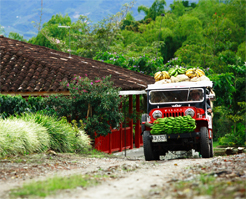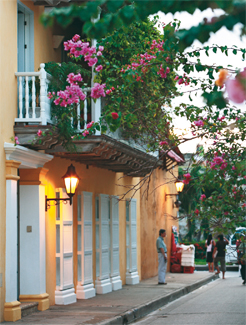Colombia Travel Guide


Telephone:
E:
Area
Colombia occupies a territory of 1.141.748 km2 (almost the same as France and Spain together), 928.660 km2 of marine areas, 1.600 km of Atlantic coast, 1.300 km of Pacific coast and three majestic mountain ranges traversed by winding roads that connect villages and cities, cultures and races.
Buses
Colombia has road connections with Venezuela and Ecuador. From Venezuela, entrance is possible to Cúcuta from San Antonio del Táchira and to Macao from Maracaibo. The least popular entry points are Puerto Carreño, Colombia and Puerto Páez or Puerto Ayacucho in Venezuela. Ecuador is connected from Tulcán to Ipiales in Colombia through the Carretera Panamericana. It is possible to reach Colombia from Brazil via Leticia through crossings of the Tabatinga River. There are also boats from Manaos (about four days) and Iquitos in Perú.
Car Rental
Most of the big international car rental companies operate in the major cities alongside local companies. All that is required for you to drive in Colombia is a full valid British or European driving license and your passport.
Climate
Colombia is located near the Equator which allows for relatively minor climate variations over the year. Temperatures vary according to altitude creating different climate zones:
Warm: temperatures above 24°C in altitudes lower than 1.000 meters, which comprises 80 % of the territory (ei.: Cartagena, Tyrona National Park, the Amazon, etc)
Tempered: temperatures between 17°C and 24°C above 1.000 and 2.000 meters (ie.: Medellin)
Cold: temperatures between 12°C and 17°C above 2.000 and 3.000 meters (ie.: Bogota)
Páramo (altiplano): temperatures below12°C with altitudes above 3.000 meters (ei. Parque Nacional Los Nevados in the Coffee Region).
Altitudes also generate differences in temperature between day and night. Clearly, as the altitude increases, so does the difference in climate. There are no variations in the low lands where days and nights are warm. Colombia experiences two seasons: the “dry” season or summer and the “rainy” season or winter. The length of the seasons and the amount of rain vary according to the regions. The Andes, for instance, have two dry and two rainy seasons a year. The main dry season stretches from December to March and July and August are rainy as well. The Llanos have a dry season from December to March and are rainy over the rest of the year. There is no uniform climate in the Amazon which is quite rainy all year round.
Cruise Ships
To enter Colombia, you need a valid passport. A visa is not required for stays up to 90 days but is required for longer stays and must be requested in the respective Colombian consulate. It is also possible to request a 30 day extension from the DA S (Departamento Administrativo de Seguridad).
Customs & Immigration
To enter Colombia, you need a valid passport. A visa is not required for stays up to 90 days but is required for longer stays and must be requested in the respective Colombian consulate. It is also possible to request a 30 day extension from the DA S (Departamento Administrativo de Seguridad).
Diving
Colombia has to extensive coastlines that offer many diving opportunities. San Andres and Providencia Islands in the Caribbean Coast that boast the third largest reef barrier in the world. In the Caribbean Coast are worth to mention the fisherman village of Tagange (nearby Santa Marta) that has been establish itself as dive centre; and Tolu (near Cartagena) while Capurgana on the Darien coast (Uraba Gulf). On the Pacific Coast Bahia Solano as well as Gorgona Island offers very good options to observe exotic fish and turtles. The remote island of Maleplo is heaven for hammerhead shark fans and experiences divers.
Dress
Lightweight clothes with waterproofs during the rainy season in coastal and northern areas. Medium- to heavyweights are needed in upland and mountainous areas.
Drink
The legal age to purchase alcoholic beverages in Colombia is 18. Colombia is the 3rd coffee producer (after Brazil and Vietnam) and its quality is recognized due to the excellence of Colombian beans. The tinto, a small cup of black coffee, is served everywhere and every time. Colombia produces many acceptable brands of beer such as Aguila, Club Colombia, Costeño and Poker. A traditional drink in Colombia is the Chicha which is a homemade beverage corn-based but sugar and/or panela are added and it is boiled. Also, the local rum is good and one of the best is Ron Viejo de Caldas and Ron Medellin.
Eating Out
In the main cities (Bogota, Medellin, Cali, Cartagena) many restaurants options are available and offers a huge vary of international and national cuisine. In smaller village and towns there will be a modest selection of places to eat.
National specialities:
• Ajiaco (chicken stew with herbs, different potato varieties, cream, corn and capers).
• Arepas (hard corn pancakes, eaten with savory toppings).
• Bandeja paisa (meat with avocado, rice, fried plantain and red beans), typical to Medellín.
• Mariscos (seafood) is a specialty on the Caribbean coast - lobsters in particular.
Tipping
Tipping: A 10% tip is usual in restaurants but it is not compulsory. In some restaurants it is included in the bill.
Duty Free
The following goods may be taken into Colombia by people 18 years of age and older without incurring customs duty:
• 200 cigarettes and 50 cigars and up to 500g of tobacco.
• Two bottles of alcoholic beverage.
• A reasonable quantity of perfume.
Electrical Current
All of Colombia uses 110 volt electricity with US type flat two pin plugs. It is best to bring an adapter.
Guide Books
Most of the major guidebook series publish titles that cover Colombia.
Health & Insurance
Colombia has a good network of private hospitals in the major metropolitan areas. Private medical care is expensive so we advise you to take out medical and travel insurance.
Language
Spanish is the official language of Colombia. English is spoken only in some areas. In the Pacif Coast, Tayrona National Park and in the natural reserves in the Amazon there are not English speaking staffs. There are also some 60 aboriginal languages spoken by the indigenous communities.
Media
There are a few locally published English language newspapers in Colombia such as The City Paper but it is a cultural and tourism newspaper, not too much information regarding Colombian economic and politic (the distribution of this newspaper is free only in Bogota). Also, foreign newspapers and magazines are not difficult to find in the main cities. Most of hotels have satellite or cable television offering original language programming from the US and Europe. In Bogota, there is a bookstore that sells national and international books in English called Authors.
Money, Banks & Credit Cards
Colombian’s currency is the peso (COP; symbol Col$). Notes are in denominations of 50,000, 20,000, 10,000, 5,000, 2,000 and 1,000. Coins are in denominations of 500, 200, 100, 50 and 20. Currency should be exchanged at hotels, banks and bureau de change only, though most places charge commission. It is suggested not to changing money on the street. The US Dollar is the easiest currency to exchange.
Credit/Debit Cards and ATMs: Visa and MasterCard are widely accepted, American Express and Diners Club less so. There are ATMs throughout the main cities; some will allow cash withdrawals using Visa, MasterCard or Cirrus.
Population
Colombia has a population of approximately 41 million, making it the South America second most populous nation, after Brazil. Population density varies a lot across the country. The western half part of the country houses the 90% of the population (the two coast & the three Andean Cordilleras where the three main cities are settled: Bogota -7millon-, Medellin and Cali -2millon each-). The eastern half part of the country is cover by the amazons rain forest and there are many areas that have never been explore yet.
Public Holidays
• January 1: New Year’s Eve
• January 6: The Three Wise Men
• March 19: Saint Joseph
• March or April in Mompox and Popayán: Easter
• April 19: Declaration of Independence
• May 1: Labor Day
• May: The Ascension
• May/June: Corpus Christi
• June: Sacred Heart
• June 29: Saint Peter and Saint Paul
• July 20: Independence Day
• August 7: Battle of Boyacá
• August 15: The Assumption of Our Lady
• October 12: Columbus Day
• November 1: All Saints
• November 11: Independence of Cartagena
• December 8: Immaculate Conception
• December 25: Christmas
Railways
In Colombia it is not a viable option of travelling around the country as there is a not railway up to today. There are two touristic railways: one departs from Bogota to Cajica (passing through Usaquen and Zipaquiera) and the other one, The Tren Turstico Cafe y Azucar, runs on weekends from Cali to La Tebaida (passing through Buga) and another line leaves Cali until Buenaventura.
Taxis
Taxis in Colombia are cheap compared to the UK and easy to find in all the major cities. In general, taxis are painted yellow or yellow and black. There are official rates and taxi has a taximeter* which is a devise that display two to three digit numbers (that stars from “25”) and its represents the price in a table rate (that always is in the taxi or can be asked to the driver).
An example: if the taxi meter* says 25, the price for the trip is COP 3.500 approx. (approx USD 2,-, it is the minimum rate).
Telephone Services
National and International can be made from the many public phone offices found throughout all main cities and even in small towns. Your British mobile phone should work if it is tri or quad band. Check with your mobile company prior to travelling.
Time
GMT – 5 hours.
Vaccinations
Most immunizations are not necessary to travel to Colombia. We nevertheless recommend asking your physician or a specialized center for more detailed information. For those travelling to the southern Amazon, Amacayacu and Gorgona National Parks, a vaccination for yellow fever and tetanus 15 days in advanced is compulsory as the diseases are endemic in some areas, as well as for passengers continuing to Brazil.
Visas
To enter Colombia, you need a valid passport. A visa is not required for stays up to 90 days but is required for longer stays and must be requested in the respective Colombian consulate. It is also possible to request a 30 day extension from the DA S (Departamento Administrativo de Seguridad).
